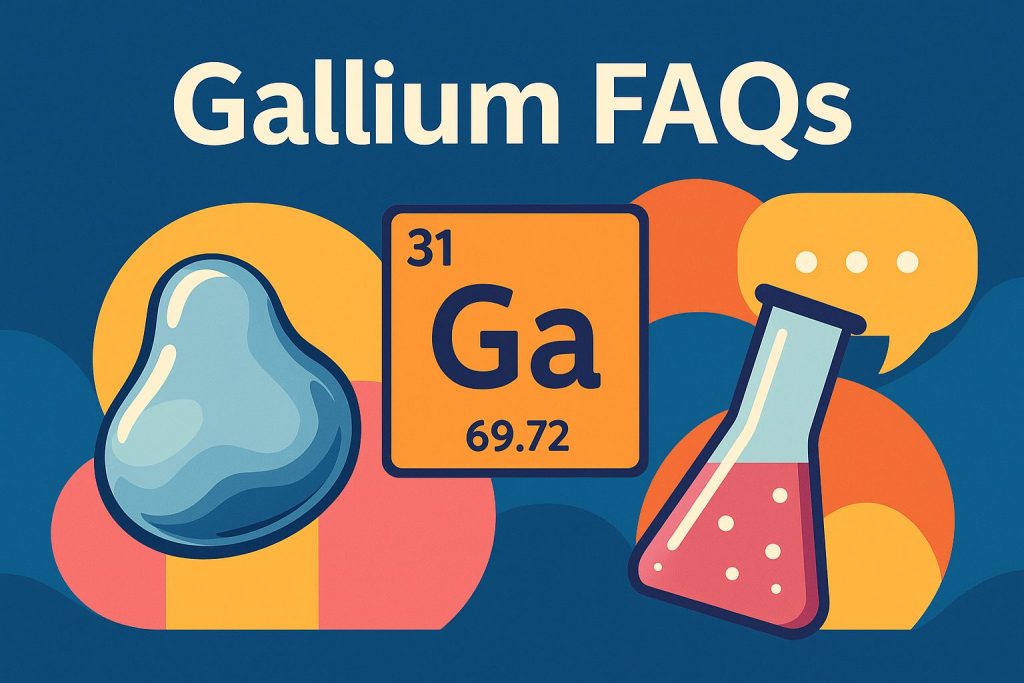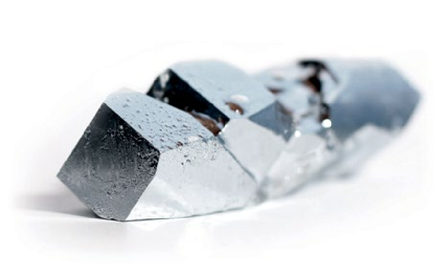The Metal That Melts in Your Hand (and Breaks Aluminum)

Gallium is one of the most fascinating — and misunderstood — elements in the periodic table. It’s a soft, silvery metal with a low melting point and a knack for disrupting aluminum structures. But, there’s more to it than just party tricks. From powering solar panels to driving LED technology, gallium is a key player in the high-tech future.
This FAQ page answers the most important questions about this strange and strategic metal.
🔬 Properties & Physical Behavior
Gallium is solid at room temperature but melts in your hand, doesn’t crystallize easily, and has a boiling point of over 2,400 °C. Its unique properties and widespread use in high-tech and green tech make it one of the quirkiest — and most important — elements today.
Gallium is a shiny, silvery metal that looks similar to mercury, but it’s solid just below room temperature.
Gallium melts at just 29.8 °C (85.6 °F), meaning it will turn to liquid in your hand. This trait makes it ideal for use in temperature-sensitive applications and as a substitute for mercury in thermometers.
Gallium can weaken and damage certain metals, especially aluminum. It infiltrates the metal’s grain structure, compromising its integrity. This can cause strong metals to become brittle and break apart — a fascinating, yet slightly alarming, chemical interaction.
Gallium breaks down the protective oxide layer on aluminum, allowing it to seep into the metal and degrade its structure. The result? Aluminum that once supported weight now crumbles like wet paper. It’s why gallium and aircraft parts do not mix.
No, gallium cannot melt steel. Its melting point is low, but it lacks the thermal energy required to melt high-melting-point metals like steel. However, gallium can weaken aluminum by destroying its structural integrity, which might look like melting.
Gallium doesn’t destroy all metals — but it’s notorious for wrecking aluminum. It penetrates the grain structure and disrupts bonding between atoms, causing the metal to lose its strength and disintegrate.
📖 History & Discovery
Gallium was officially discovered in 1875.
Gallium was discovered by French chemist Paul Émile Lecoq de Boisbaudran. He identified the element using spectroscopy while examining zinc ores. Interestingly, the name “Gallium” pays tribute to both France (Gallia in Latin) and possibly the discoverer himself — since “le coq” means “rooster” in French, and “Gallus” is Latin for rooster.
Gallium is element number 31, found in group 13 of the periodic table, nestled between zinc and germanium. It’s classified as a post-transition metal.
🌍 Origin & Production
Gallium is a chemical element, not a compound, so it isn’t “made of” anything. It exists on its own on the periodic table (symbol: Ga, atomic number: 31) and is produced through extraction from other ores during refining processes.
Gallium is not found in its pure form in nature. It’s usually extracted as a by-product from mining and processing bauxite (for aluminum) and sphalerite (for zinc). The largest producer is China, which dominates the global supply.
Gallium is not mined directly. Instead, it’s recovered as a by-product of refining other metals, primarily bauxite (aluminum ore) and sphalerite (zinc ore). The world’s dominant producer is China, which accounts for more than 80% of global output. Other contributors include Germany, Kazakhstan, and Ukraine — but China controls the lion’s share of both production and export, making gallium a strategic chess piece in global trade.
Exact reserves are not widely published, but the U.S. imports most of its gallium, primarily from China. Domestic production is minimal. Due to its strategic importance, gallium is on the U.S. critical minerals list.
⚙️ Uses & Applications
Gallium is used in semiconductors, solar panels (thin-film), LEDs & OLEDs , smartphones & computers, and laser technologies. It’s a key enabler of the tech that powers our modern lives.
Gallium is crucial for modern electronics, renewable energy, and communications. Without it, we wouldn’t have efficient LEDs, fast semiconductors, or thin-film solar panels, making it a linchpin in the green and digital revolutions.
Gallium’s price reflects its rarity and the complexity of its extraction. It’s not mined directly but recovered from other ores in small quantities. With demand rising in electronics and China limiting exports, supply constraints have also nudged up the price.
🧪 Safety & Handling
Gallium is considered non-toxic and safe to handle in small amounts. However, it can cause skin irritation and is harmful to metals like aluminum. For your safety and the safety of your furniture, it should not be ingested or used around structural metals.
While gallium isn’t classified as highly toxic, it’s still not safe to ingest. It can cause gastrointestinal irritation and may contain impurities.
Gallium’s unique properties — such as its low melting point, high boiling point, and semiconductive behavior — make it useful in electronics, solar cells, and LEDs. It works by forming compounds (e.g., gallium arsenide) that control electrical current with high precision.
You can’t “make” gallium in the backyard. It’s a natural element extracted from by-products during aluminum and zinc refining. Any suggestion of home production is impractical and potentially hazardous.
💼 Buying, Investing & Storage
While small quantities of gallium can be found on hobbyist websites, these are not suitable for investment purposes. If you’re looking to purchase high-purity, industrial-grade gallium as a tangible asset, it’s best to work with a specialised dealer. We offer gallium in certified packaging and investment-grade form, sourced directly from top global producers. Unlike retail platforms, our metals come with full documentation and an easy resale option to industry buyers.
You can invest in gallium by purchasing and physically owning it, either outright or as part of a diversified basket of strategic & precious metals. At Strategic Metals Invest, we make this possible for private investors. You’ll receive industrial-quality gallium, a Certificate of Ownership (ISO-9001 standard), and optional storage in a secure, tax-free bunker. Gallium is especially attractive as a medium- to long-term investment, given its strategic importance and tightening global supply.
Gallium should be stored in a sealed container, away from air and aluminum. For serious investors, we recommend professional storage in a high-security vault, like our partner METLOCK’s facility in Frankfurt. This ensures your metals are protected against fire, theft, and oxidation. It also simplifies resale later as you have direct access to our more than 4,000 industry buyers in 70 different countries when you are ready to sell. Our storage solution includes banking-grade security (class 10 CD EX), full insurance coverage, and secure packaging to preserve purity and liquidity.
As you can see, gallium isn’t just a scientific curiosity; it’s a strategic asset with rising importance in modern technology and green energy. If you’d like to learn more about how gallium (and other strategic technology metals) can fit into your investment portfolio, we’re here to help. Contact us for more information.


